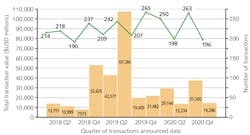Frothy public markets and new normals fuel photonics M&A and IPO markets
The photonics mergers & acquisitions (M&A) market stalled in Q2 2020 because of pandemic uncertainty; however, frothy public markets, access to low interest debt, and fears of increasing U.S. capital gains tax appear to be fueling a quick recovery. Technology companies that address the new normals not only have survived, but continue to grow at an expected faster pace. Further, private-equity leveraged buyouts and venture-capital backed emerging technology IPOs surged in 2020.
While shy of 2019, the value and volume of M&A transactions for pure-play photonics companies and companies with core photonics technology in 2020 were on pace with 2018. In 2020, almost 95% of acquisitions of photonics-enabled targets involve strategic buyers, compared to 80% in 2019. It may be that strategic buyers are more capable in getting deals done remotely with more intimate knowledge of the sellers and their markets. Similar to previous years, most private equity buyouts are smaller add-ons to larger platform companies (see Fig. 1).
In 2020, the Biophotonics, Diagnostics segment in particular, sees the most activity and highest total value of all photonics-enabled sectors. Within Diagnostics, the largest transactions are Quebec B.V.’s (Breda, Netherlands) acquisition of QIAGEN N.V. (NYSE:QGEN; Venlo, Netherlands) for $13 billion; Illumina Inc.’s (NasdaqGS:ILMN; San Diego, CA) acquisition of GRAIL, Inc. (Menlo Park, CA) for $8 billion, and Invitae Corp.’s (NISE:NVTA; San Francisco, CA) acquisition of ArcherDx, Inc. (Boulder, CO) for $1.4 billion. Acquired companies develop polymerase chain reaction (PCR) products that are detected and analyzed with fluorescence-based DNA sequencing, electrochemiluminescence, or other fluorescence-labeled methods. All are addressing cancer, with QIAGEN’s COVID-19 diagnostic and research portfolio making headlines this year.
Consistent with the market as a whole, 2020 marks a resurgence of carve-outs and divestitures from companies seeking cash. Koninklijke DSM N.V. (ENXTAM:DSM; Heerlen, Netherlands) divested its optical fiber coatings manufacturing operations for $1.9 billion. Cree, Inc. (NasdaqGS:CREE; Durham, NC) divested its LED chips and LED components manufacturing business for $300 million. Saab AB (publ) (OM:SAAB B; Stockholm, Sweden) divested its remaining 30% stake in Vricon, Inc. (McLean, VA), provider of 3D geodata and visualization solutions, for $140 million. And L3Harris Technologies, Inc. (NYSE:LHX; Melbourne, FL) divested its holographic weapon sights and night vision product lines for $42 million.
No single buyer was very acquisitive. The most active buyers, so far in 2020, are BOE Technology Group Company Limited (SZSE:000725; Beijing, China), an Internet-of-Things company acquiring display businesses; Hexatronic Group AB (publ) (OM:HTRO; Hudiksvall, Sweden) acquiring providers of fiber-optic cables, training test equipment businesses, and training; and Suzhou TFC Optical Communication Co., Ltd. (SZSE:300394; Suzhou, China) acquiring optical communications component companies, including coating supplier Auxora’s Shenzhen, China operation for $14 million (0.9x revenue).
Few transactions report financials because regulations do not require them when a transaction does not have material near-term impact on financial statements. Of the researched transactions, 28 report implied enterprise value (IEV)/earnings before interest, taxes, depreciation, and amortization (EBITDA) greater than 1X. Values are in $US at historical rates of exchange. Companies employing core photonics technology and innovative business models across a wide breadth of vertical markets continue to realize very high valuations (see Fig. 2).Leading the pack on IEV/EBITDA for acquisitions of majority share are Exalenz Bioscience Ltd. (Modi’in, Israel) (188X), supplier of noninvasive breath diagnostic devices to detect gastrointestinal and liver conditions employing molecular correlation spectroscopy and Apteryx Imaging Inc. (TSXV:XRAY; Vancouver, BC, Canada) (48X), dental imaging hardware and software provider. Following in the pack, Atlas Copco AB (OM:ATCO A; Nacka, Sweden) acquired both Perceptron, Inc. (NasdaqGM:PRCP; Plymouth, MI) (34X), supplier of automated industrial metrology products and Isra Vision AG (XTRA:ISR; Darmstadt, Germany) (32X), provider of robotic vision systems.
Valuations of pure-play photonics companies, 5X to 12X IEV/EBITDA, continue to lag valuations of companies in the vertical markets they serve.
Despite the pandemic, 2020 marks a boom across the IPO market fueled by frothy public markets, a wave of special-purpose acquisition companies (SPACs), and individual shareholders wanting to lock in lower capital gains rates. A SPAC is a company formed strictly to raise capital through an IPO for the purpose of acquiring existing companies. It is an attractive go-to-market strategy, given the ability to quickly go to market at high valuations with lower levels of scrutiny relative to traditional IPOs.
Lidar companies are in the 2020 wave of SPACs following OmniVision Technologies, Inc. (Santa Clara, CA) in 2016 and Terra Imaging, LLC (Telluride, CO) in 2014. Velodyne Lidar, Inc. (NasdaqGS:VLDR; San Jose, CA) started publicly trading following the completion of its business combination with SPAC Graf Industrial Corp. (Houston, TX). At year-end, its market capitalization was $3.9 billion. Luminar Technologies, Inc. (NasdaqGS:LAZR; Orlando, FL), with strategic investments from Volvo, Daimler, and MobileEye, entered the public markets via a combination with SPAC Gores Metropoulos, Inc. (Beverly Hills, CA). As of year-end, its market capitalization is $11.0 billion. In November 2020, Porsche-backed lidar startup AEVA, Inc. (Mountain View, CA) announced it would merge with SPAC InterPrivate Acquisition Corp. (NYSE:IPV; Greenbrae, CA) at a $2.1 billion post-deal market valuation.
Lidar companies face a legacy auto industry that is historically slow to innovate and has robust levels of competition. Startups compete with Alphabet, Inc. (NasdaqGS:GOOG.L; Mountain View, CA), Apple (NASDAQ: AAPL; Cupertino, CA), Amazon.com, Inc. (NasdaqGS:AMZN; Seattle, WA), and Intel Corporation (NASDAQ: INTC; Santa Clara, CA), which have substantial strategic interests in the future of transportation.
Looking to 2021 and beyond, venture capital and private equity investments in photonics-enabled sectors such as mobility technology, industrial automation, and agricultural technology are setting the stage for the next waves of healthy exits in the private and public markets.
Advanced farm equipment, including drones and robotic smart field equipment, is dependent on photonics. Investing in solutions addressing climate change and population growth, VC funding grew to $4.1 billion in 2019, a 32.7% 10-year compound annual growth rate (CAGR). This activity could translate to future healthy exits for photonics-enabled hardware companies.
For example, in 2020, AgroFresh Solutions, Inc. (NasdaqGS:AGFS; Philadelphia, PA), PGS ASA (OB:PGS; Lysaker, Norway), GL Tech Co., Ltd (SZSE:300480; Zhengzhou, China), SemiosBio Technologies Inc. (Vancouver, BC, Canada), Changsha Kaiyuan Instruments Co., Ltd (SZSE:300338; Changsha, China), and Zero Mass Water, Inc. (Scottsdale, AZ) raised more than $50 million each.
Based on the financial markets, it appears that photonics technology companies did much more than survive the pandemic in 2020. They are continuing to revolutionize society through medicine, communications, transportation, and information.
NOTE: Ceres Technology Advisors sources transaction data from public sources. Ceres analysis and data are subject to errors and omissions. Accuracy of information is responsibility of user.

Linda Smith | President, Ceres Technology Advisors
Linda Smith is a recognized leader in M&A advisory. Spanning the spectrum of photonics-enabled markets, she advised on acquisitions and financings valued at more than $1.5 billion. She founded CERES in 2005 to serve photonics companies underserved by generalist investment bankers. Prior, she held product management, engineering, and sales positions at public and private equity-financed photonics companies.

